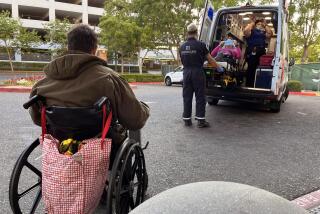Domino Effect Feared From Closures of Emergency Rooms
- Share via
Los Angeles County, which has lost six emergency rooms in a little over a year, is on the brink of a far more serious problem, facing more closures that could jeopardize emergency care for tens of thousands of residents, according to public officials and independent analysts.
The next round of cuts is expected to target large, heavily used emergency rooms at private hospitals. If they proceed as expected, they will reduce by a further 10% to 15% the county’s emergency room capacity, which already has lost the ability to serve 75,000 patients in the last 14 months, hospital and healthcare officials say.
“We’re cutting off limbs to stay alive,” said Jim Lott, executive vice president of the Hospital Assn. of Southern California.
Public officials and some healthcare economists warn that further closures of large emergency rooms could set off a chain reaction. As uninsured patients move from closed emergency rooms to others that are already under financial strain, those facilities too could close.
Hospital officials have been warning of a crisis for the last 15 years, and have used the issue to gain support from the state and federal governments. An initiative on the November ballot supported by doctor groups would impose a 3% surcharge on telephone bills to pay for additional emergency services and other health costs.
But even some experts who have been skeptical about past warnings are now taking the prospect of closures seriously.
Glenn Melnick, a healthcare economist at USC who has cautioned in the past against exaggerating the loss of emergency room capacity in the county, said the loss or reduction of one of the city’s major inner-city hospitals, which officials now predict, could be devastating to the fragile emergency system.
“If true, this suggests the predicted meltdown may actually be starting,” he said.
County Supervisor Gloria Molina, whose district includes two of the emergency rooms that officials warn are most at risk, said the problem has been “a crisis in the making for a couple of years, and it’s coming to a head.”
“It’s very precarious for every single one of us,” she said. “Whether you have insurance or not, if there’s not a bed for you, you’re not going to get in.”
Hospital officials would not publicly name the specific hospitals facing cutbacks and say final decisions have not been made.
But officials familiar with the situation listed three hospitals whose emergency rooms are among those considered at risk: Good Samaritan Hospital and California Hospital Medical Center near downtown Los Angeles and Downey Regional Medical Center in the southern part of the county.
Officials at each of these three hospitals emphasized that no decisions have been made about closing or downgrading emergency rooms. But they emphasized that they are facing severe economic crises that could cause them to consider such moves in the near future.
Good Samaritan Hospital is losing $10 million per year through its emergency room because of an increase in uninsured patients, hospital officials said.
“We have to look at all and any options available to us right now,” said hospital President Andrew Leeka. He said he “can’t guarantee that we won’t close our [emergency room] doors by the end of the year.”
Downey Regional Medical Center’s emergency room is losing $2 million per year, and is considering a downgrade in status to save money that would turn away an estimated 5,000 ambulances each year, said Robert Fuller, the hospital’s executive vice president. The emergency room treats 51,000 patients each year and has seen its nonpaying population double in the last 12 months, Fuller said.
California Hospital Medical Center also has seen its number of uninsured patients double in the last year, and is generating significant losses through its emergency room, officials said.
One hospital industry figure familiar with the numbers put the losses generated by California Hospital’s emergency room as significantly higher than Good Samaritan’s.
Though officials said they had no current plans to close the emergency room, “the unprecedented rise in the number of uninsured forces us to reevaluate our options,” said Katreena Salgado, a hospital spokeswoman.
Shutting down any of those hospitals’ emergency rooms could lead to a scenario of cascading closures that has been feared for years.
“If Good Samaritan and California Hospital close their ERs or go to standby, other inner-city hospitals will follow,” said Carol Meyer, director of the Los Angeles County Emergency Medical Services Agency.
Several factors have contributed to the problem, but the overwhelming one, according to hospital officials and healthcare economists, is the weight of the county’s huge population of people without health insurance, who account for 1 in 3 emergency room visits.
Historically, about two-thirds of those patients have been served by the four county-run hospitals and a number of county-run clinics. A handful of inner-city private hospitals have served most of the remaining third, said Lott, of the Hospital Assn. of Southern California.
But a year ago, to save money, the financially strapped county government changed its policies to limit the ability of private hospitals to ship uninsured patients to the public system. That cut the number of uninsured patients transferred to the public hospitals by more than 40%, Meyer said.
In addition, 16 county clinics were closed in 2002 to save costs. The result is that over the last 14 months, the number of uninsured patients has doubled in some private hospitals and tripled in others, Lott said. Each additional closure compounds the problem, and makes it more likely other hospitals will follow.
The problem of the uninsured is “like a gaping laceration that is hemorrhaging continuously,” said E. Richard Brown, a healthcare expert at UCLA who studies the uninsured. A third of California’s 6.3 million uninsured live in the Southland, and the number is growing rapidly, he said.
Economists emphasize that the closure of individual hospitals, alone, is not necessarily a danger. In a series of studies on emergency room usage in California published last year, USC’s Melnick found that although the number of emergency rooms in Los Angeles County had declined by 21% from 1990 to 2000, overall capacity had increased by 9%, faster than population growth, as the remaining hospitals expanded. But that process of expansion is only successful if hospitals can bring in enough paying customers to cover their costs. If expansion brings in only more uninsured patients, it merely deepens a hospital’s financial problems.
Two other factors have been cited by a number of hospital officials to explain the recent closures. One is a set of earthquake retrofit requirements adopted after the 1994 Northridge earthquake. In response to the quake, the state required hundreds of buildings in California to be retrofitted to prevent a catastrophic collapse, and set a deadline of 2008 for compliance. Extensions now make it possible for many hospitals to put off that deadline until 2013.
Of the 122 hospitals in Los Angeles County affected by the law, 109 have submitted plans or requested extensions. The remaining 13 have not responded to the legislation, and have until Jan. 1, 2007, to file requests for extensions.
Another factor cited by hospitals is a new law that took effect in January requiring a specified nurse-to-patient ratio in hospitals throughout California, which has one of the worst nursing shortages in the country.
Hospital officials say that requirement, which came with no state money to implement it, had driven up staff costs, which typically make up close to 60% of a hospital’s operating costs.
But Melnick, the USC healthcare economist, doubts the requirement has led to closures. “The nursing issue hits everybody,” Melnick said. “It’s driving higher healthcare costs, but is not a closure issue.”
*
(BEGIN TEXT OF INFOBOX)
Emergency rooms at risk
In the last 14 months, six emergency rooms in Los Angeles County have closed their doors or announced plans to do so, and at least three more are under heavy financial pressure.
Some emergency rooms at risk: Good Samaritan Hospital California Hospital Medical Center Downey Regional Medical Center
Hospital closures: Granada Hills Community Hospital Northridge Hospital Medical Center, Sherman Way Campus* Century City Hospital** Elastar Community Hospital Santa Teresita Hospital Community Hospital of Gardena (ER only)
*Expected to close by end of the year. **Expected to reopen later this year. Source: Times reports Graphics reporting by Jason Felch
More to Read
Sign up for Essential California
The most important California stories and recommendations in your inbox every morning.
You may occasionally receive promotional content from the Los Angeles Times.










